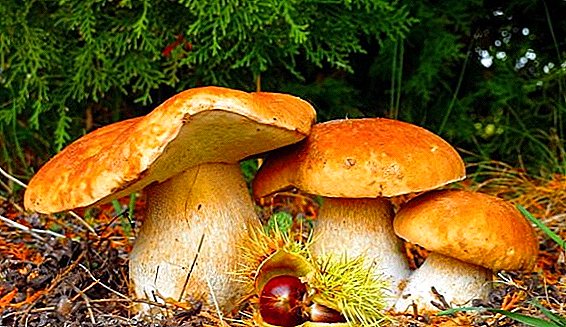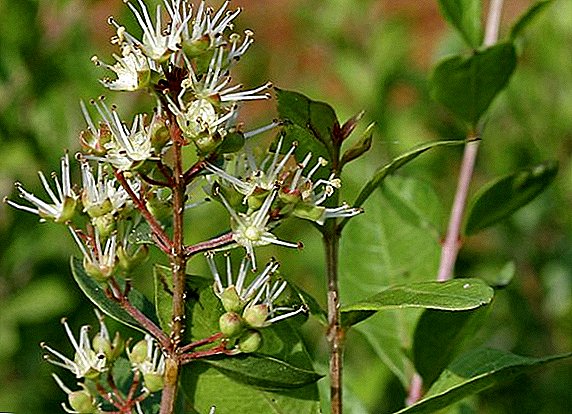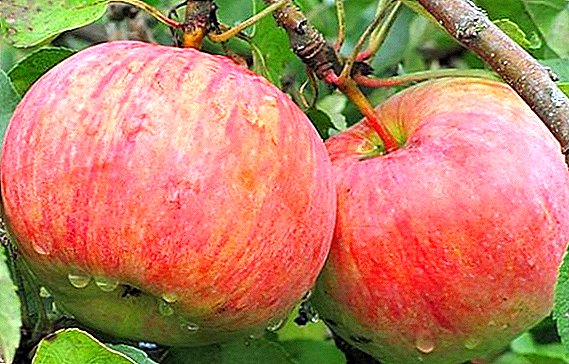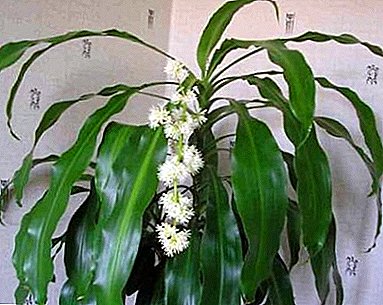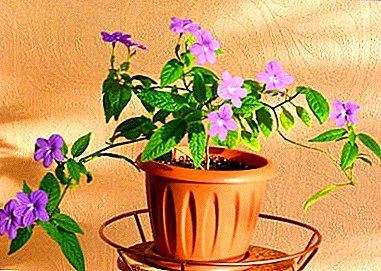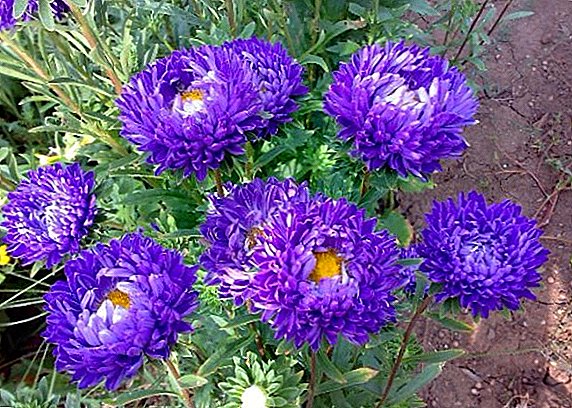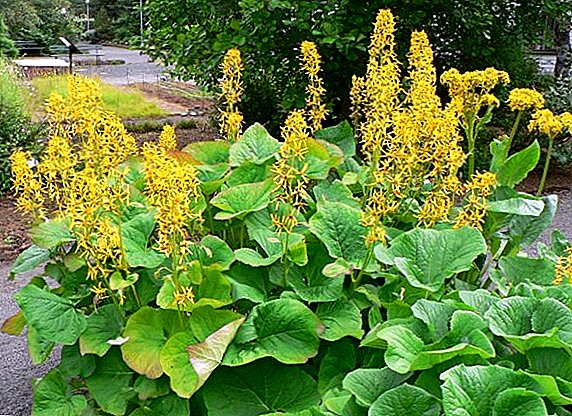 If you like “sunny” tones, you like tall and slender flowers, then you should pay attention to buzulnik (ligularia). This flower is appreciated by gardeners for its extravagance and beautiful flowering. The plant can grow to a height of two meters and on each inflorescence to have a lot of flowers resembling tongues of flame. That is why the Latin name of the Boozer is Ligularia (tongue).
If you like “sunny” tones, you like tall and slender flowers, then you should pay attention to buzulnik (ligularia). This flower is appreciated by gardeners for its extravagance and beautiful flowering. The plant can grow to a height of two meters and on each inflorescence to have a lot of flowers resembling tongues of flame. That is why the Latin name of the Boozer is Ligularia (tongue).
What is remarkable about the buzulnik and what species and varieties are used as decorative ones, we will consider below.
Prusvalsky Buzulnik (Ligularia przewalskii)
This type of bouzulnik grows to 1.5-2 meters. At the time of flowering flowers have a bright yellow color. Flower baskets are small, pulled together in long (50-70 cm) and narrow buds in the shape of candles. Pretty unpretentious and does not require special care. With the help of this flower, you can both decorate the fence and hide some unsightly places (for example, a compost pit). The most well-known variety of the Prushelysky bouzulnik - The Rocket. Its leaves are heart-shaped green in spring and purple-crimson in autumn. Flowering begins in mid-July and pleases with its beauty until mid-August. Peduncles are directed upwards, and arrow-shaped inflorescences consist of yellow flowered baskets.
Buzulnik toothed (Ligularia dentata)
These plants look spectacular, reaching a height of 1 meter. In landscape design, the buzulnik toothed is considered the most optimal for garden growing, because it fits perfectly in any garden and will always attract attention.
Important! The buzulnik is notothed, moderately winter-hardy, but in the harsh winter it is better to cover it.
Flowers dentate ligulyarii light brown or yellow. The flowering period is summer-autumn.
The most famous varieties:
- Britt Marie Crawford (Britt Marie Crawford);
- Desdemona (Desdemona);
- Othello (Othello);
- Osiris Fantasy (Osiris Fantasy).
Did you know? Ligularia is little affected by pests. Among the main can be distinguished slugs and powdery mildew. Both problems are rare and easily fixed.
In the Dezdemona bazulnik, the leaves are large (40 cm), light green with a bronze tint on top and lilac-brown at the bottom, the edges are notched. Due to this bright contrast, the plant looks elegant. Flowers Desdemona orange or fiery orange. Flowering begins from the end of August and pleases the eye until mid-October. The inflorescences of Desdemona are large - 10–13 cm. In contrast to other species, the buzulnik toothed Osiris Fantasy belongs to dwarf plants and does not grow above 50 cm. The leaves at Osiris are dark brown above and burgundy from below. Blossom starts in July. Otello grows slightly higher than Osiris (up to 90 cm). It has very large green leaves with a purple edging, the size of which is on average 50 cm. Otello blooms with magnificent large orange flowers with a diameter of 13 cm. This variety looks harmonious among greenery and stands out for its tangerine color. Blossom buzulnik Othello begins from early September and continues until the first frost.
Otello grows slightly higher than Osiris (up to 90 cm). It has very large green leaves with a purple edging, the size of which is on average 50 cm. Otello blooms with magnificent large orange flowers with a diameter of 13 cm. This variety looks harmonious among greenery and stands out for its tangerine color. Blossom buzulnik Othello begins from early September and continues until the first frost.
Did you know? The birthplace of the buzulnik cog is China, and it has been used in culture since 1900. A valuable feature is that the plant grows well in the shade.
The recently bred varieties of the Orange Queen and Dark Beauty1 bouzulnik are distinguished by their tolerance for the sun and the gentle texture of the foliage.
Wilson Buzulnik (Ligularia wilsoniana)
It is a 150 cm tall plant with straight, somewhat branched stems and large basal leaves. Best of all species tolerates dry conditions. Wilson's buzulnik blooms with numerous yellow small baskets - up to 2.5 cm. The inflorescences are erect. The flowering period - 35-40 days, begins to bloom in July.
Important! If solar conditions are created for the bouzulnik Wilson, it will blossom worse and become lower.
Buchulnik Wicha (Ligularia veitchiana)
Like many types of buzulnik, Vicha reaches a height of two meters. It has a spike inflorescence, yellow flowers. Differs large heart-shaped green leaves (up to 40 cm). Flowering begins in August, moderately frost resistant. Bouzulniki Wicha occupy a worthy place in the design of the garden.
Buzulnik Vorobyova (Ligularia vorobievii)
Homeland of this tall perennial plant, reaching two meters in height, is the Far East. Begins to bloom in August and pleases with its beauty until the end of September. The flowers of this species of bouzulnik are bright yellow baskets in the racemes, the leaves are rounded, leathery, thick, dark green in color. Bushes in the bush Vorobyov powerful - 120 cm in diameter.
Buzumnik Kempfer (Ligularia kaempferi)
This type of bushulnik is of Japanese origin. Its stems are slightly branched. Kempfer leaves uneven-toothed, rounded, 25 cm across. It blossoms with numerous light yellow baskets of small diameter (5 cm), which form erect corymbose inflorescences. Begins to bloom in July. For winter, requires surface mulch coating. Kempfer has an early flowering variety Aureomarginata with flowers of golden color and bright green round leaves with golden inclusions. This species begins to bloom in May.
Large-leaved Buzulnik (Ligularia macrophylla)
This species grows in Western Siberia, Central Asia, and the Far East. It selects places near water bodies, on wet meadows and is distinguished by yellow racemes, frost-resistant. The lower leaves of the large-leaved bouzulnik are bluish, long-petiolate, oval, 30-45 cm long. It blooms with numerous yellow baskets collected in a brush-like panicle. Stem - up to 150 cm. Flowering begins in mid-summer.
Did you know? There are about 150 species of bazulnik growing in Africa, Asia and Europe. Several species grow in the Caucasus and in Europe. In the post-Soviet space there are about 40 species. Greater species diversity is found in Central Asia (15) and in the Far East (13). Fewer species on Sakhalin (2) and Kuriles (1).
Buzulnik palchatolopastny (Ligularia x palmatiloba)
This species has another name - longitudinal. It grows up to 1.8 meters in height and almost a meter in diameter. Basal leaves are large, rounded, with deep lobes. Flowers at palchatolopastnogo buzulnika large, yellow, collected in racemes. Flowering begins in July and continues to delight gardeners until autumn. Quite picky about soil moisture.
Siberian Buzulnik (Ligularia sibirica)
This species is low compared to many other varieties of the buzulnik - only one meter in height. It has a heart-shaped or arrow-shaped reddish-green leaves, striated stems. The flowers of the Siberian buzulnik are collected in oblong brushes, the color is dark yellow.
Important! Multi-colored leaves of buzulnikov acquire a green tint due to insufficient lighting.
Buzulnik Tangut (Ligularia tangutica)
Homeland of this species - China. A less well-known name is Tangut synagogue or Tangut crossbook. They grow this species sometimes in botanical gardens. A very spectacular plant, partly reminiscent of its fellow - Przewalski's ligularia, but differs from it in the tuber-like root. Tuber develops stolons, and the Tangut buzulnik thus easily propagates vegetatively. Stems of this species have little branching, their height is 70-90 cm. The leaves are openwork, with narrow lobes, deep pinnately dissected. It blooms in July-August with small yellow flowers in an elongated inflorescence. Unpretentious, optimal conditions - wet clay soil in a shady place.
Stems of this species have little branching, their height is 70-90 cm. The leaves are openwork, with narrow lobes, deep pinnately dissected. It blooms in July-August with small yellow flowers in an elongated inflorescence. Unpretentious, optimal conditions - wet clay soil in a shady place.
Bulbroot (Ligularia stenocephala)
This species is similar to Przewalski's ligularia, only its flowers are much larger, and the leaves are heart-shaped and sharply serrated. In the autumn period, the leaves acquire an elegant purple-crimson color. In the wild, narrow-leaved buzulnik is found in China and Japan. Frost-resistant
Fischer Buzulnik (Ligularia fischeri)
Pretty unpretentious view, which pleases with its flowering in July and August. In the wild, it is found on the territory of Siberia, Mongolia, in China, Japan, in the Far East on wet meadows, in thickets of bushes. Fisher inflorescences consist of baskets (3-45 pieces on the inflorescence) with bright yellow flowers. The leaves are rosette heart-shaped (less commonly spear-shaped) 12-23 cm long. The height of the Fischer's bush is 0.3-1.5 meters.
Buzulnik Hessei (Ligulariaxhessei)
This species is a hybrid of Wilson's ligulyary and dentate. It has its own subspecies, which differ in the color of leaves and the shape of inflorescences (Laternchen, Gregynog Gold). Hessei has heart-shaped leaves and chamomile-like flowers, similar to the inflorescences of toothed buzulnik. Flowering begins at the end of summer. The bush at the plant is powerful, reaches a height of 1.5 meters.
In addition to the described, such types and hybrids of the buzulnik are popular as:
- Altai (Ligularia altaica);
- Alpine (Ligularia alpigena);
- Arctic (Ligularia arctica);
- Chinese (Ligularia chinensiana);
- Hybrid (Ligularia hybride);
- Zepter (Ligularia Zepter).
 If you want to add monumentality to your flower bed or arrange a cottage in a rustic style, planting a bouzulnik will help solve this. In the spring, they will delight with the view of blooming leaves, in the summer they will surprise with fiery blooms, and in the fall they will decorate the garden with elegant foliage.
If you want to add monumentality to your flower bed or arrange a cottage in a rustic style, planting a bouzulnik will help solve this. In the spring, they will delight with the view of blooming leaves, in the summer they will surprise with fiery blooms, and in the fall they will decorate the garden with elegant foliage.

